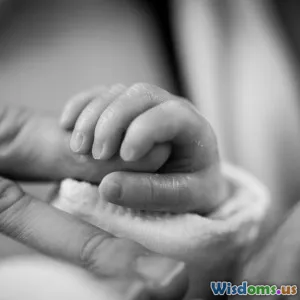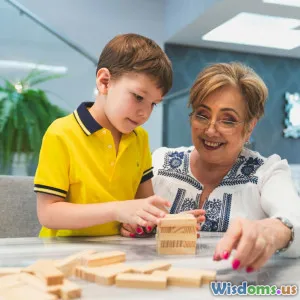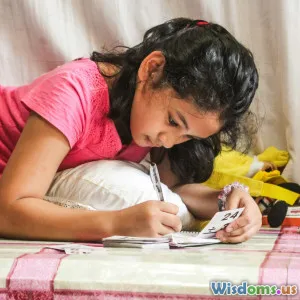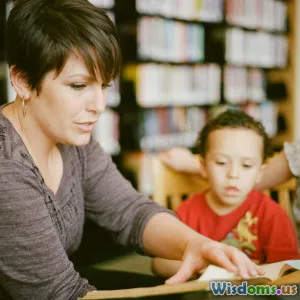
Why Birth Order Still Decides Some Family Responsibilities
11 min read Explore how birth order influences family duties, shaping roles, expectations, and responsibilities across generations with compelling examples and scientific insights. (0 Reviews)
Why Birth Order Still Decides Some Family Responsibilities
The notion that birth order determines personality traits and family roles is an enduring idea that often sparks lively debate. But beyond personality quips—"firstborns are leaders and perfectionists," "youngest children are free spirits"—birth order profoundly affects how family responsibilities are distributed. From who cares for aging parents to who takes the helm during family crises, birth order remains a significant factor in family dynamics.
In this article, we’ll explore the enduring impact of birth order on family responsibilities. We will unpack psychological research, sociocultural patterns, and real-world examples that reveal why knowing your spot in the birth lineup matters more than you might expect. Whether you’re a firstborn wondering why you always manage family affairs, or a youngest feeling overlooked, understanding this phenomenon can illuminate how family systems function and evolve.
Historical and Psychological Foundations of Birth Order Roles
Alfred Adler’s Birth Order Theory
The concept of birth order influencing behavior and responsibility began with Alfred Adler, a pioneering psychologist in the early 20th century. Adler observed that firstborn children often received intensive parental attention initially but faced challenges when a sibling arrived, causing rivalry and shifts in family dynamics. He theorized that firstborns tend to identify with adult authority figures and often develop roles involving leadership and caretaking.
This theory sparked decades of psychological research exploring how birth order shapes not just personality but also roles within the family. The foundational belief is that family systems unconsciously assign responsibilities aligned to birth order as a way to preserve balance and meet the family’s evolving needs.
Sibling Roles: Caregiver, Peacemaker, Strategist
Building on Adler’s insights, research has found distinct patterns:
- Firstborns: Tend to take on leadership and caregiver roles. They often act as “second parents,” especially in larger families. Studies show they are more likely to assume responsibilities like managing household tasks, monitoring younger siblings, and even mediating conflicts.
- Middle children: Often positioned as peacemakers and negotiators, they may juggle competing family interests but tend to avoid dominant roles, leading some middle children to feel overlooked.
- Youngest children: Frequently occupy less responsibility-centric roles, often benefiting from the experience and guidance of older siblings but also sometimes tasked with breaking family traditions or bringing fresh perspectives.
These roles are neither fixed nor universal, varying by family culture, size, gender dynamics, and individual circumstances, but patterns persist strongly across many families and societies.
Why Birth Order Dictates Family Responsibilities
Evolutionary and Cultural Perspectives
In many cultures, family responsibility isn’t handed at random. The oldest child historically was groomed to inherit property, lead family affairs, and carry forward traditions, while younger siblings often had more fluid roles. This positioning isn’t arbitrary; it helped maintain continuity through generations and ensured the family’s survival.
For example, in traditional Chinese and Indian families, the eldest son or daughter may be expected to take primary responsibility for aging parents and familial decision-making. In some Scandinavian cultures, older siblings assume delegated caregiving roles, which both family and social systems endorse.
A Case Study: Caregiving Among Siblings
A 2018 study published in the Journal of Gerontology examined caregiving among adult siblings caring for elderly parents. The researchers found firstborns were 50% more likely to be the primary caregivers compared to their younger siblings. Moreover, they often took on coordinating medical appointments, managing finances, and liaising with healthcare providers.
This responsibility assignment often comes from explicit parental expectation or implicit family norms, reflecting trust in the eldest’s perceived maturity and reliability. Interestingly, some younger siblings willingly defer these duties, recognizing the practical burden that caregiving imposes.
Family Crisis and Leadership
When crises strike, family leadership often defaults to oldest siblings. This dynamic holds true regardless of age: whether it's managing a major family event like a wedding, dealing with a sudden death, or navigating financial hardship, oldest siblings frequently step into leadership roles.
Anecdotal evidence also supports this: Sarah, a 34-year-old firstborn from Texas, recounts how she coordinated all funeral arrangements and family communications after her father passed, even though she lived out of state. "My siblings naturally looked to me for guidance, and I suppose it was because I was the oldest," she admits. “It felt like a birthright responsibility.”
Variables That Influence Birth Order Effects
Gender and Cultural Nuances
While birth order confers generalized roles, gender intersections play a critical role. In patriarchal families, eldest sons might inherit leadership and responsibility roles, but in matrilineal societies, eldest daughters might be caretakers. Meanwhile, in egalitarian families, responsibilities might be more equally shared regardless of birth order.
Family Size and Composition
In small families with two children, birth order effects might be subtle but still significant. In larger families, roles become more complex, sometimes forcing middle children to act as mediators or second caregivers.
Moreover, blended families and those with significant gaps in sibling ages might demonstrate less typical patterns. For instance, an eldest child essentially acting as a surrogate parent due to large age gaps, or youngest siblings holding unusual responsibilities due to parental health.
Personality and Individual Choices
Birth order does not doom anyone to a specific role; individuals can and do push back against family expectations. Personalities, values, and external circumstances affect how responsibilities are accepted or resisted.
Birth Order in Modern Family Dynamics
Changing Societal Norms
Modern families are more diverse, with varying compositions including single-parent households, dual-career parents, and increased geographic mobility. These changes slightly erode traditional birth order-based roles but don’t erase them.
For example, adult children who live far apart might distribute caregiving duties by practicality rather than birth order, yet still lean on older siblings for coordination and decision-making.
Technology and Communication
Today’s connected world enables older siblings to manage responsibilities remotely. Messaging groups, video calls, and shared online calendars allow firstborns to coordinate caregiving or family events with greater efficiency.
Work-Life Balance and Birth Order Responsibilities
Increasingly, younger generations are renegotiating family role expectations. Millennials and Gen Z adults may defer caregiving roles or share them more equitably. Nevertheless, birth order often shapes who takes the initiative.
Conclusion: Birth Order’s Persistent Influence
Despite changing social norms, evolving family structures, and individual personality variance, birth order remains a powerful determinant of family responsibilities. These implicit and explicit roles help families organize around caregiving, leadership, and crisis management.
What’s more, understanding these dynamics can help families address unwritten expectations openly, distributing responsibilities more fairly and reducing sibling resentment. Recognizing birth order’s influence offers actionable insights for both parents raising children and adults navigating family duties.
Ultimately, birth order doesn’t lock anyone into static roles, but it definitely seeds the ground for who shoulders responsibility when family matters most. Embracing and communicating about these roles can strengthen familial bonds and promote shared support across all siblings—oldest, middle, and youngest alike.
References:
- Belmont, L.D., & Marolla, F.A. (1973). Birth Order and Achievement. Psychological Reports.
- Sulloway, F.J. (1996). Born to Rebel: Birth Order, Family Dynamics, and Creative Lives. Pantheon.
- Gilligan, M., Suitor, J.J., & Pillemer, K. (2018). Giving to the One You’re Not Responsible For: Competing Commitments Among Siblings Caring for a Parent. Journal of Gerontology: Social Sciences.
- Ernst, L.R., & Angst, M.A. (2013). The Effect of Birth Order on Personality Traits. Journal of Behavioral Science.
Whether you’re reflecting on your own family’s dynamics or guiding future expectations, birth order offers a meaningful lens through which to understand who steps forward—and why—when family responsibilities arise.
Rate the Post
User Reviews
Popular Posts



















